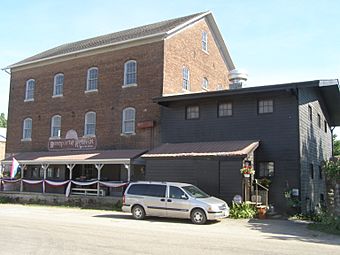Meek's Flour Mill facts for kids
Quick facts for kids |
|
|
Meek's Flour Mill
|
|
|
U.S. Historic district
Contributing property |
|
 |
|
| Location | 1st St. Bonaparte, Iowa |
|---|---|
| Area | less than one acre |
| Built | 1878 |
| Part of | Bonaparte Historic Riverfront District (ID89000313) |
| NRHP reference No. | 83000406 |
| Added to NRHP | January 27, 1983 |
The Meek's Flour Mill is a historic building in Bonaparte, Iowa. It stands as a reminder of the town's early days. The town was first called Meek's Mill. It was named after William Meek, who helped start the settlement in 1837. Later, the town was renamed Bonaparte in 1841. However, the Meek family remained very important to the town's growth for many years.
A Look at the Mill's History
The mill building you see today was built in 1878. It replaced an older mill from 1844 that was destroyed by fire. William Meek's son, Robert, built this new mill. His brothers, Isaiah and Joseph, helped him. The mill is a three-story building with a pointed roof. It sits on a strong base made of limestone blocks.
What Happened to the Mill?
The Meek's Flour Mill was a busy place for many years. Around 1900, Grant C. Scott and Stephen Blackburn ran the mill. The last person to operate it as a flour mill was Daniel Cresap. In 1905, a big flood damaged the mill's dam. This made it impossible to run the mill.
The building then sat empty for over 20 years. In 1928, it became a feed store, selling food for farm animals. It stayed a feed store until 1963. After that, the Farmers Cooperative Association used the building until 1977. Later, it was turned into a restaurant.
A Place in History
The Meek's Flour Mill is important because of its long history. In 1983, it was added to the National Register of Historic Places. This is a list of important buildings, sites, and objects in the United States. Being on this list helps protect historic places. Six years later, the mill also became part of the Bonaparte Historic Riverfront District. This means it is a key part of a larger historic area in Bonaparte.



